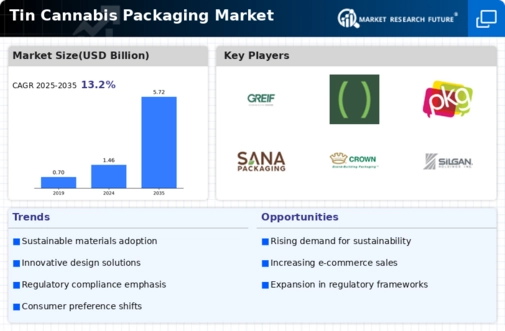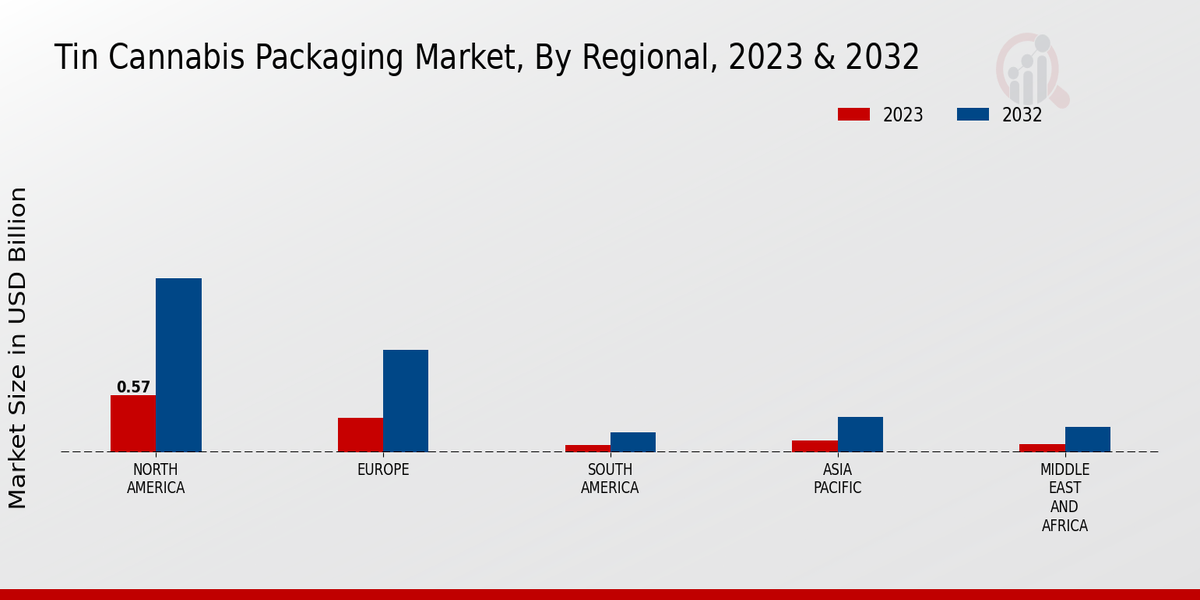Market Growth Projections
The Global Tin Cannabis Packaging Market Industry is poised for substantial growth, with projections indicating a market value of 1.46 USD Billion in 2024 and an anticipated increase to 5.72 USD Billion by 2035. This growth trajectory suggests a robust demand for tin packaging solutions, driven by factors such as legalization trends, sustainability, and consumer preferences for premium products. The industry is expected to experience a compound annual growth rate (CAGR) of 13.21% from 2025 to 2035, highlighting the dynamic nature of the market and the potential for innovation and investment in packaging technologies.
Growing Legalization of Cannabis
The increasing legalization of cannabis across various regions appears to be a primary driver for the Global Tin Cannabis Packaging Market Industry. As more countries and states embrace cannabis for both medicinal and recreational use, the demand for compliant and appealing packaging solutions rises. This trend is evidenced by the projected market value of 1.46 USD Billion in 2024, which is expected to grow significantly as regulations evolve. The need for secure, tamper-proof packaging that meets legal standards is paramount, thus driving innovation and investment in tin packaging solutions tailored for cannabis products.
Technological Advancements in Packaging
Technological innovations in packaging design and production are driving the Global Tin Cannabis Packaging Market Industry forward. Advances in printing technology, for instance, allow for high-quality graphics and branding on tin containers, enhancing product visibility and consumer engagement. Moreover, the integration of smart packaging technologies, such as QR codes and anti-counterfeiting measures, is becoming more prevalent. These advancements not only improve the consumer experience but also ensure compliance with regulatory requirements. As the industry continues to innovate, the market is expected to grow at a CAGR of 13.21% from 2025 to 2035, reflecting the importance of technology in packaging solutions.
Sustainability and Eco-Friendly Packaging
Sustainability concerns are becoming increasingly prominent in consumer preferences, influencing the Global Tin Cannabis Packaging Market Industry. Tin packaging is often perceived as a more environmentally friendly option compared to plastic alternatives, as it is recyclable and can be reused. This aligns with the growing demand for sustainable practices within the cannabis sector. Companies that adopt eco-friendly packaging solutions may enhance their brand image and appeal to environmentally conscious consumers. As the market evolves, the emphasis on sustainable packaging is likely to contribute to the projected growth of the industry, potentially reaching 5.72 USD Billion by 2035.
Regulatory Compliance and Safety Standards
Regulatory compliance plays a crucial role in shaping the Global Tin Cannabis Packaging Market Industry. As governments implement stringent safety standards for cannabis products, the demand for packaging that meets these regulations increases. Tin packaging is often favored for its ability to provide a secure barrier against contaminants, ensuring product integrity and safety. This aspect is particularly important as the market expands, with projections indicating a growth to 5.72 USD Billion by 2035. Companies that prioritize compliance in their packaging solutions are likely to gain a competitive edge in this evolving landscape.
Rising Demand for Premium Cannabis Products
The increasing consumer preference for premium cannabis products is influencing the Global Tin Cannabis Packaging Market Industry. As consumers become more discerning, they seek products that offer quality and sophistication, which often necessitates high-end packaging solutions. Tin packaging, with its durability and aesthetic appeal, is well-suited to meet these demands. This trend is reflected in the market's projected growth, with an anticipated value of 1.46 USD Billion in 2024. Companies that invest in premium packaging are likely to differentiate themselves in a competitive market, thereby driving further growth in the tin packaging segment.


















Leave a Comment